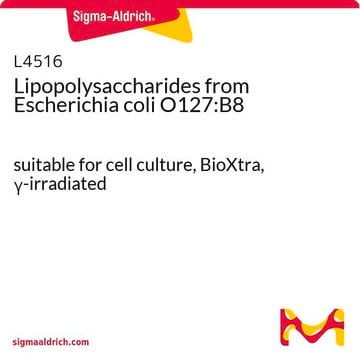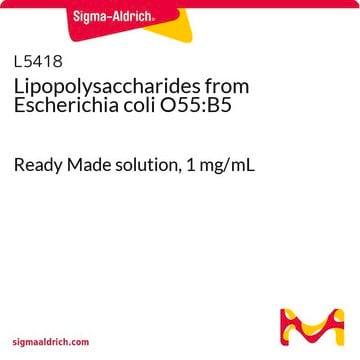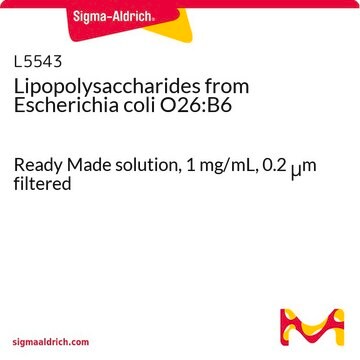L6529
Lipopolysaccharides from Escherichia coli O55:B5
γ-irradiated, BioXtra, suitable for cell culture
Sinónimos:
LPS
About This Item
Productos recomendados
origen biológico
Escherichia coli (O55:B5)
Nivel de calidad
esterilidad
γ-irradiated
Línea del producto
BioXtra
formulario
lyophilized powder
purificado por
gel-filtration chromatography
técnicas
cell culture | mammalian: suitable
impurezas
<3% Protein (Lowry)
solubilidad
H2O: 5 mg/mL, faintly hazy to hazy
temp. de almacenamiento
2-8°C
¿Está buscando productos similares? Visita Guía de comparación de productos
Descripción general
Aplicación
- to stimulate human PBMC to secrete cytokine.
- to stimulate wild type embryonic fibroblasts and mutants for the induction of phosphorylation of p56
- in the measurement of tumor necrosis factor-α levels and nuclear factor-κB p65 activities after stimulation
- in the stimulation of hamster lymphocytes in vitro
- to induce activated dendritic morphology in murine macrophage cell line in a study
Acciones bioquímicas o fisiológicas
Reconstitución
Otras notas
Producto relacionado
Palabra de señalización
Danger
Frases de peligro
Consejos de prudencia
Clasificaciones de peligro
Acute Tox. 2 Oral
Código de clase de almacenamiento
6.1A - Combustible acute toxic Cat. 1 and 2 / very toxic hazardous materials
Clase de riesgo para el agua (WGK)
WGK 3
Punto de inflamabilidad (°F)
Not applicable
Punto de inflamabilidad (°C)
Not applicable
Equipo de protección personal
Eyeshields, Gloves, type N95 (US)
Certificados de análisis (COA)
Busque Certificados de análisis (COA) introduciendo el número de lote del producto. Los números de lote se encuentran en la etiqueta del producto después de las palabras «Lot» o «Batch»
¿Ya tiene este producto?
Encuentre la documentación para los productos que ha comprado recientemente en la Biblioteca de documentos.
Los clientes también vieron
Artículos
Explore the structure, function, and diverse applications of Lipopolysaccharides. Discover their role in bacteria, serological specificity, and research potential.
Nuestro equipo de científicos tiene experiencia en todas las áreas de investigación: Ciencias de la vida, Ciencia de los materiales, Síntesis química, Cromatografía, Analítica y muchas otras.
Póngase en contacto con el Servicio técnico




